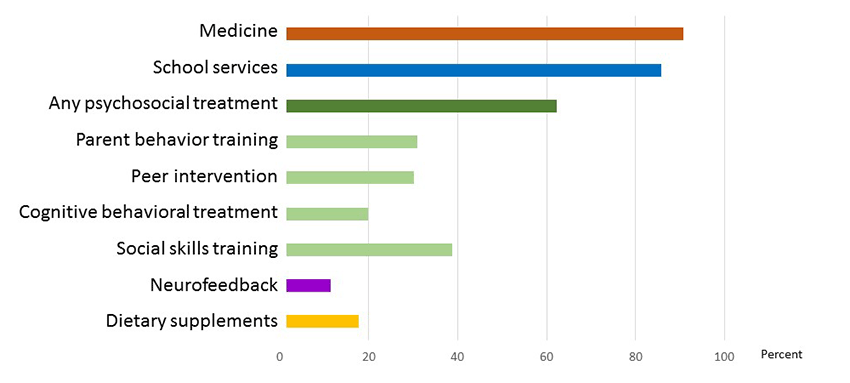 The Journal of Pediatrics published a study that looks at the different types of treatment received by U.S. children, aged 4-17 years, diagnosed with attention-deficit/ hyperactivity disorder (ADHD). Experts recommend using both medicine and behavior therapy for children over 6 years of age and using behavior therapy as the first line of treatment for children under 6 years of age. CDC researchers found the most common treatment for ADHD is medicine, and the majority of children have not received any type of behavior therapy.
The Journal of Pediatrics published a study that looks at the different types of treatment received by U.S. children, aged 4-17 years, diagnosed with attention-deficit/ hyperactivity disorder (ADHD). Experts recommend using both medicine and behavior therapy for children over 6 years of age and using behavior therapy as the first line of treatment for children under 6 years of age. CDC researchers found the most common treatment for ADHD is medicine, and the majority of children have not received any type of behavior therapy.
This study is relevant for healthcare providers and public health professionals so that they can understand possible gaps in treatments that families may experience. You can read a scientific summary of the study here.
How Effective Are Different Types of Treatment?
Based on the best available evidence, effective strategies include treating ADHD with medicine, parent-delivered behavior therapy, and teacher-delivered behavior therapy. The American Academy of Pediatrics (AAP) recommends that children 6 years or older be treated with medicine or behavior therapy, preferably in combination. Parent-delivered behavior therapy is used as the first-line treatment for children younger than 6 years. The AAP also recommends that schools participate in any ADHD treatment plan, including support and accommodations, such as preferred seating and modified exams, homework, or school assignments.
Researchers have previously reviewed the treatments for ADHD, looking at whether different types of psychosocial treatments for ADHD were effective. They found that behavioral peer intervention, which is a form of behavior therapy where teachers train other students to support a child’s positive behaviors, could be effective. The information on using dietary supplements or neurofeedback for treatment was too limited to determine whether they were effective. Social skills training, alone, which focuses on children’s ability to interact and communicate with others, was not found to be effective. Learn more about the review of treatments for ADHD.
Main Findings from the StudyInformation from parents about their child’s previous and current treatment for ADHD showed the following:
- 9 out of 10 children with ADHD received medicine for ADHD at some point in their lives.
- Just under 9 out of 10 children with ADHD received school support at some point in their lives, which includes school accommodations and help in the classroom.
- 6 out of 10 children with ADHD received some type of psychosocial treatment at some point in their lives:
- 3 out of 10 received parent-delivered behavior therapy, which is the type of behavior therapy recommended for children up to age 12.
- 4 out of 10 received social skills training.
- 3 out of 10 received peer interventions.
- 2 out of 10 received cognitive behavioral therapy, a type of therapy that focuses on changing a child’s thoughts and emotions that can affect behavior in negative ways.
- Parents also reported on alternative treatments for children with ADHD:
- About 1 out of 10 received neurofeedback.
- About 2 out of 10 had taken dietary supplements.
- Overall, about 7 of 10 children had received at least two of the three main treatments: medicine, school support, or some type of psychosocial treatment; less than 1 in 10 (7%) had received none of these.
Proportion of children with ADHD who received different types of treatments

About the Study
The study used data from the 2014 National Survey of the Diagnosis and Treatment of ADHD and Tourette Syndrome, which was a follow-back telephone survey of parents whose children were identified to have ADHD in the 2011-12 National Survey of Children’s Health. In this follow-back survey, parents answered detailed questions about the different types of treatment their child previously and currently received.
CDC’s National Center on Birth Defects and Development Disabilities (NCBDDD) and National Center for Health Statistics sponsored this survey.
CDC’s Activities
NCBDDD is committed to helping children with ADHD and their families get the support they need. With our partners, NCBDDD
- Studies how common ADHD is and how children with the condition are being treated.
- Identifies potential gaps in children’s access to the right treatment.
- Provides resources and information to parents, healthcare providers, and state and local decision-makers so that children and families can get the support they need as early as possible.
Read more about CDC’s work on ADHD.
Key Findings Reference
Danielson ML, Visser SN, Chronis-Tuscano A, DuPaul GJ. A national description of treatment among U.S. children and adolescents with ADHD. Journal of Pediatrics. Published online before print, November 10, 2017. [read summary]
More information
- CDC’s work on ADHD
- National Resource Center on ADHD
- Page last reviewed:Â November 13, 2017
- Page last updated:Â November 13, 2017
- Content source:
- Division of Human Development and Disability, National Center on Birth Defects and Developmental Disabilities, Centers for Disease Control and Prevention
 -
1600 Clifton Road Atlanta, GA 30329-4027 USAÂ
800-CDC-INFO (800-232-4636), TTY: 888-232-6348
Email CDC-INFO
- Division of Human Development and Disability, National Center on Birth Defects and Developmental Disabilities, Centers for Disease Control and Prevention

